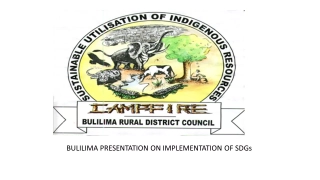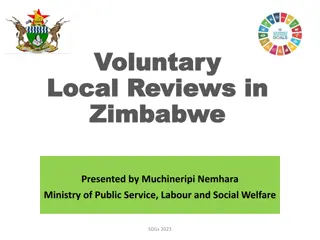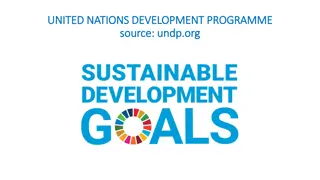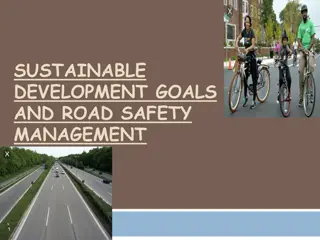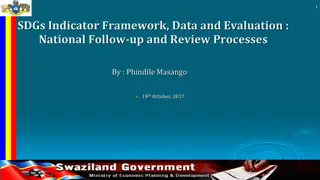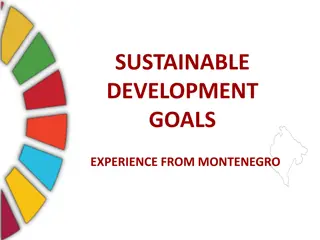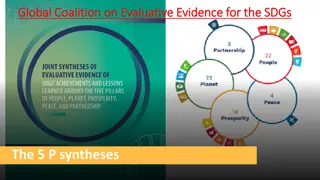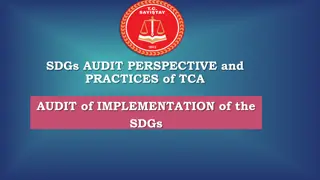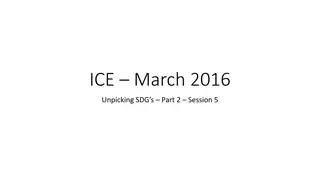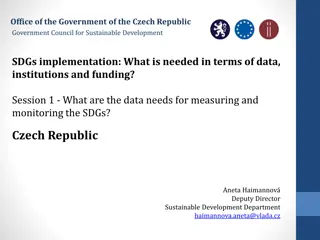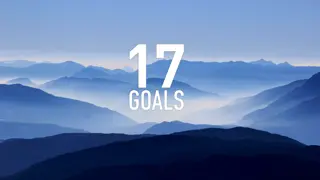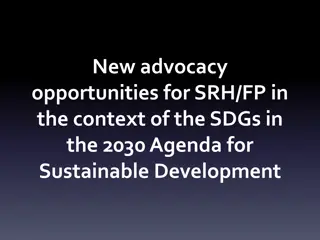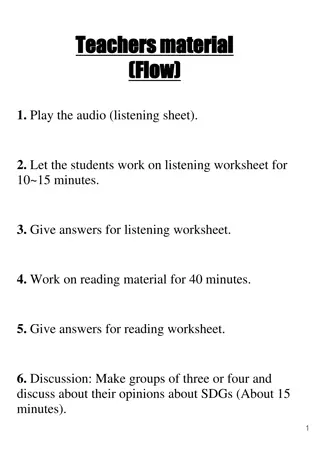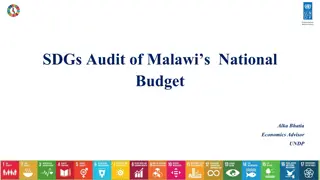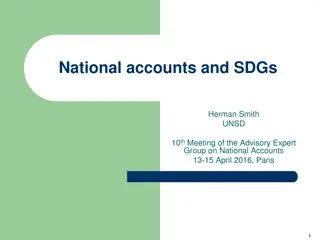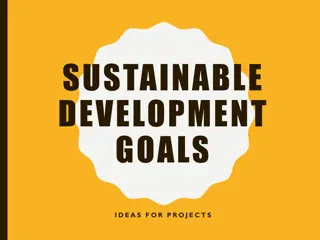Evolution of Global Development Goals: From MDGs to SDGs
The international community transitioned from the Millennium Development Goals (MDGs) to the Sustainable Development Goals (SDGs) in 2015 to address poverty, inequality, climate change, and more. MDGs focused on eight goals, whereas SDGs expanded to 17 goals covering various aspects of sustainable development by 2030.
Download Presentation

Please find below an Image/Link to download the presentation.
The content on the website is provided AS IS for your information and personal use only. It may not be sold, licensed, or shared on other websites without obtaining consent from the author.If you encounter any issues during the download, it is possible that the publisher has removed the file from their server.
You are allowed to download the files provided on this website for personal or commercial use, subject to the condition that they are used lawfully. All files are the property of their respective owners.
The content on the website is provided AS IS for your information and personal use only. It may not be sold, licensed, or shared on other websites without obtaining consent from the author.
E N D
Presentation Transcript
SDG 6 TARGETS AND INDICATORS TRACKING PRESENTED FOR WESNET AT EKWENDENI BY: JEREMIAH SAKALA 26THFEBRUARY 2020
OVERVIEW - THE POLITICAL PROCESS 1992: Agenda 21 (Rio) 2002: World Summit on Sustainable Development 2012: The Future we Want (Rio+20) 2015: Sustainable Development Goals
MILLENNIUM DEVELOPMENT GOALS - The Millennium Development Goals (MDGs) were the eight international development goals for the year 2015 that had been established following the Millennium Summit of the United Nations in 2000, following the adoption of the United Nations Millennium Declaration. All 189 United Nations member states at the time (there are 193 currently), and at least 23 international organizations, committed to help achieve the following Millennium Development Goals by 2015: 1) To eradicate extreme poverty and hunger 2) To achieve universal primary education 3) To promote gender equality and empower women 4) To reduce child mortality 5) To improve maternal health 6) To combat HIV/AIDS, malaria, and other diseases 7) To ensure environmental sustainability 8) To develop a global partnership for development
SUSTAINABLE DEVELOPMENT GOALS - At the United Nations Sustainable Development Summit on 25/09/15, world leaders adopted the 2030 Agenda for Sustainable Development, which includes a set of 17 Sustainable Development Goals (SDGs) to end poverty, fight inequality and injustice, and tackle climate change by 2030. Sustainable Development Goals(SDGs) Sustainable Development Goals(SDGs) Goal 1 End poverty in all its forms everywhere Goal 2 End hunger, achieve food security and improved nutrition and promote sustainable agriculture Goal 3 Ensure healthy lives and promote well-being for all at all ages Goal 10 Goal 11 Reduce inequality within and among countries Make cities and human settlements inclusive, safe, resilient and sustainable Ensure sustainable consumption and production patterns Goal 12 Goal 4 Ensure inclusive and equitable quality education and promote lifelong learning opportunities for all Achieve gender equality and empower all women and girls Goal 13 Take urgent action to combat climate change and its impacts Goal 5 Goal 14 Conserve and sustainably use the oceans, seas and marine resources for sustainable development Protect, restore and promote sustainable use of terrestrial ecosystems, sustainably manage forests, combat desertification, and halt and reverse land degradation and halt biodiversity loss Promote peaceful and inclusive societies for sustainable development, provide access to justice for all and build effective, accountable and inclusive institutions at all levels Strengthen the means of implementation and revitalize the global partnership for sustainable development Goal 6 Ensure availability and sustainable management of water and sanitation for all (6.a, 6.b) Goal 15 Goal 7 Ensure access to affordable, reliable, sustainable and modern energy for all Goal 16 Goal 8 Promote sustained, inclusive and sustainable economic growth, full and productive employment and decent work for all Build resilient infrastructure, promote inclusive and sustainable industrialization and foster innovation Goal 17 Goal 9
MDG & SDG COMPARISON MDG SDG Traditional assistance Traditional assistance + Universal goals More comprehensive Inclusive goal setting Traditional + Data revolution Distinction Quality Education Broader set of financial sources Limited goals Top-down process Traditional statistics Hunger and poverty together Quantity Education Funding: Focus on ODA
SDG #6 Target 6.1 By 2030, achieve universal and equitable access to safe and affordable drinking water for all Indicator 6.1.1 Proportion of population using safely managed drinking water services 6.2 By 2030, achieve access to adequate and equitable sanitation and hygiene for all and end open defecation, paying special attention to the needs of women and girls and those in vulnerable situations 6.2.1 Proportion of population using safely managed sanitation services, including a hand-washing facility with soap and water 6.3 By 2030, improve water quality by reducing pollution, eliminating dumping and minimizing release of hazardous chemicals and materials, halving the proportion of untreated wastewater and substantially increasing recycling and safe reuse globally 6.3.1 Proportion of wastewater safely treated 6.3.2 Proportion of bodies of water with good ambient water quality
SDG #6 CONT. Target 6.4 By 2030, substantially increase water-use efficiency across all sectors and ensure sustainable withdrawals and supply of freshwater to address water scarcity and substantially reduce the number of people suffering from water scarcity Indicator 6.4.1 Change in water-use efficiency over time 6.4.2 Level of water stress: freshwater withdrawal as a proportion of available freshwater resources 6.5 By 2030, implement integrated water resources management at all levels, including through transboundary cooperation as appropriate 6.5.1 Degree of integrated water resources management implementation (0 100) 6.5.2 Proportion of transboundary basin area with an operational arrangement for water cooperation 6.6 By 2020, protect and restore water-related ecosystems, including mountains, forests, wetlands, rivers, aquifers and lakes 6.6.1 Change in the extent of water-related ecosystems over time
SDG #6 CONT. Target 6.a By 2030, expand international cooperation and capacity- building support to developing countries in water and sanitation-related activities and programmes, including water harvesting, desalination, water efficiency, wastewater treatment, recycling and reuse technologies Indicator 6.a.1 Amount of water- and sanitation-related official development assistance that is part of a government coordinated spending plan 6.b Support and strengthen the participation of local communities in improving water and sanitation management 6.b.1 Proportion of local administrative units with established and operational policies and procedures for participation of local communities in water and sanitation management
INDICATOR DETERMINATION EXAMPLE; SDG 6.4 ????? ????? ??? ????? ?? ???????? ?????? ????????? 6.4.1 = ????? ????? ??? ?????? ????? ?????????? ????? ????????? ????????? 6.4.2 =
THE CHALLENGE AHEAD NEED TO FOCUS ON QUALITY NOT QUANTITY REQUIRES HIGHER STANDARDS FOR PROGRAMMING REQUIRES INCREASED FOCUS ON INSTITUTIONS SCHOOLS AND HEALTH FACILITIES INCREASED NEED FOR ACCURATE DESIGNING, MONITORING AND EVALUATION. MORE INDICATORS, RIGOROUS REQUIREMENTS AND DISAGGREGATED INFORMATION.

